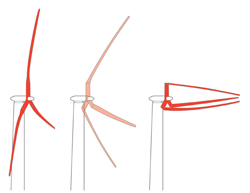The following links describe a method for lighter and larger blades working like palm trees in order to be resilient from high winds.

Perhaps some applications in AWES could be imagined, knowing the global loads issue could be mitigated with appropriate bridling, starting with a central line for the hub. Then several options would include torque transfer TRPT rotor in @Rodread’s way, or yo-yo mode (recovery phase by the third position). Perhaps keeping lift (without lifter kite) would be possible with a cyclically controlled bridling.
This topic could also be connected to Info on different methods for making rigid propellers, wind turbine blades, wings and similar.
3 Likes
Old concept ladies. Often imitated, sometimes duplicated, but so far they haven’t caught on. A company called “The Wind Turbine Company”
http://www.windturbinecompany.com/technology.html
raised funding about 15 years ago and built a very large prototype near a friend of mine’s house in Lancaster, California. This turbine quickly destroyed itself. One more example of building a big version before you have a proven small version. Since wind is invisible, would-be designers can imagine whatever optimal, problem-free behavior they wish for, but their wishes often do not reflect real-world behavior. The turbine I mentioned ended up as a heap of scrap on the ground. Two-bladed rotors spin even faster than 3-blade rotors. The tower’s “wind shadow” hits the blades like a hard “smack”, ripping the machine apart.
1 Like
A post was merged into an existing topic: Questions and complaints about moderation.
